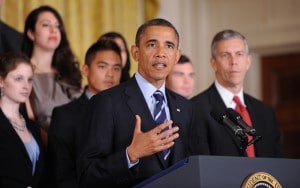There’s a lot at stake for college students in this election, but perhaps no issue more immediate than student loans. Barack Obama and Mitt Romney have strikingly divergent stances on this issue, stances that have real consequences for your wallet and for the role of government in supporting opportunity and advancement for next generations. Every college student needs to know what the candidates stand for and make an informed choice this November.
During his first term, President Obama signed a law making it easier for students to pay back their federal college loans. When the law goes into effect in 2014, recent graduates will pay no more than 10 percent of their disposable income toward student loan payments. And after 20 years, any remaining debt will be forgiven. Those work in public service, who become teachers or firefighters or join the military, will have all their debt forgiven 10 years after they graduate.
And while historically, banks have backed student loans with the government guaranteeing those loans and subsidizing the lower interest rates, President Obama cut out the middle man _ saving the government an estimated $58 billion over a 10-year period. Most of that savings was used to bolster Pell Grants and funding programs for Historically Black Colleges and Universities.
Meanwhile, earlier this year, Republicans in Congress tried to block the renewal of a law that cut federal student loan rates in half. In fact, the House Republican budget _ authored by now-Republican vice presidential candidate Paul Ryan _ explicitly called for allowing student loan rates to double.
The Ryan budget plan also calls for kicking one million students off of Pell Grants.
But as candidate, Mitt Romney supported extending the rate cut for student loans while at the same time embracing Paul Ryan’s budget that would double loan rates. This is where things get sticky. We know what President Obama has done in office with respect to student loans. Mitt Romney remains a frequently flip-flopping man of mystery.
So what has Mitt Romney pledged going forward? He would reverse President Obama’s policy and bring private lenders back into the federal student loan business, a move that would cost taxpayers billions of dollars and jeopardize the Pell Grant investments President Obama made with the savings from reform.
Notably, the student loan banking industry has donated massive sums to Mitt Romney’s campaign and zero to President Obama. And notably, several of those companies were also caught in scandal where banks offered perks to college financial aid officers and revenue-sharing agreements if loans were steered to certain banks.
When President Obama said, “You didn’t build that,” he was referring to the public infrastructure that supports and sustains private entrepreneurship in America. And yes, that infrastructure includes our nation’s college students. After all, through federal student loans and grants, the government literally subsidizes the education of the next generation of engineers, teachers and executives. In 1947, World War II veterans benefiting from the GI Bill accounted for 49 percent of all college admissions, which laid the groundwork for American prosperity and opportunity in the decades to come.
Today, 34 percent of college students rely at least to some extent on federal loans to pay for their education though far less generous and comprehensive than the GI Bill.
Still, as a national community, we invest in student loans to make college more accessible to all Americans and invest in the talent our economy needs.
No one knows for sure what Mitt Romney would do in office, whether he would govern as the Massachusetts centrist he once tried to be or as a Tea Party puppet he’s now become. But what is clear is that President Obama, who just finished paying off his own student loans eight years ago personally appreciates the struggles of today’s college students _ and took concrete steps in his first term to strengthen the federal student loan and grant programs for those who need them.
The Romney-Ryan team is on record with wanting to privatize and cut student loans, while President Obama passed laws to lower student debt and make college more affordable. You don’t have to take a class in economics to know the choice is clear.
Story written by Sally Kohn for McClathy-Tribune (MCT)















